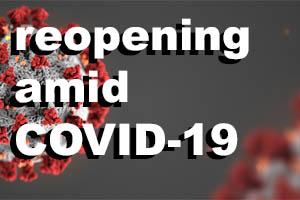


COVID-19 Balancing Act: How to Communicate as you Reopen Your Business
[by Howard Fencl, Hennes Communications] We’re all still fully engaged fighting the invisible threat of COVID-19 on every level. We’re trying to keep ourselves from getting it. We’re trying to keep our families safe. And for companies deemed non-essential, we’re trying to conduct some semblance of business while kids, cats and dogs Zoombomb our virtual team meetings.
We’re about to turn an important page in the pandemic story. As COVID-19 cases peak and plateau across the U.S., the federal government has set a goal – start reopening the economy on May 1. Many states have begun planning how to slowly reopen their economies.
This brings up some important questions: What exactly are the reopening plans in the states where your company operates, and how do they differ? What’s your company doing right now to prepare? Who are the audiences you must communicate your plans to, and when should you begin?
As you might expect, these plans vary greatly from state to state and are subject to change, particularly if reopening parts of the economy touches off a second wave of COVID-19 infections. Some examples:
- In California, the current stay-at-home order has no set end date. While important medical procedures such as heart and cancer surgeries are being phased back in, the state is pulling back on issuing permits for activities at all state facilities.
- Illinois is extending its stay-at-home order to May 30. The state is talking about reopening industry-by-industry – and maybe company-by-company.
- In Michigan, Gov. Gretchen Whitmer extended the state’s stay-at-home order to May 15, and but also relaxed restrictions so some businesses can reopen.
- Ohio’s stay-at-home order expired on May 1, and the state has begun its first phase in reopening its economy, called “Responsible RestartOhio” with sector-specific requirements for businesses to open.
What we do know is that businesses will be expected to prioritize workplace safety for employees, customers, vendors and visitors. That’ll no doubt include rigorous, enhanced cleaning and disinfecting protocols. Face masks may be the new normal for every company dress code. Social distancing will continue to be critical.
We’ll almost certainly be looking at phased-in returns to business in many of our areas. That could include limiting the number of people in a business at any one time or having employee teams alternate working on-site. If you’re running a 24/7 operation, it could also include creative approaches already in place at Proctor & Gamble’s Pennsylvania Charmin factory, where staggered shift changes, employee fever checks, and workplace zone restrictions have succeeded – the plant has been in continuous operation throughout the crisis and has not logged a single positive COVID-19 case among its 2,200 employees.
It’s not too soon to plan your communications as the nation slowly reopens the economy:
- Reach out regularly to employees, customers, vendors and community leaders to let them know your preliminary reopening plans. With the avalanche of negative pandemic news over many weeks, your audiences will be open to hearing positive news – no matter how general.
- Communicate detailed plans as soon as they are available.
- If you are a multi-state operation, communications should be tailored to cover how your reopening plans will follow each state’s specific requirements.
- Be certain communications of detailed plans are posted to your employee intranet, facility bulletin boards, facility signage, and in regular employee communications tools such as newsletters, blogs, private social media groups, etc.
- Continue communicating safety measures your company has undertaken, and overcommunicate new policies and procedure you are putting in place.
- Continue updating internal audiences with pertinent safety and operational information shared by local and state health departments, and by the Centers for Disease Control (CDC).
In a recent coronavirus briefing, Ohio Gov. DeWine dug up a chestnut Churchill tossed off in World War II that applies to the COVID-19 situation now upon us: “…Now this is not the end. It is not even the beginning of the end. But it is, perhaps, the end of the beginning.” Just as it is critical that organizations continue doing everything in their power to protect the well-being of employees during this next crucial phase, it is critically important to overcommunicate changes your company is undertaking to protect employees and protect the future of your business.